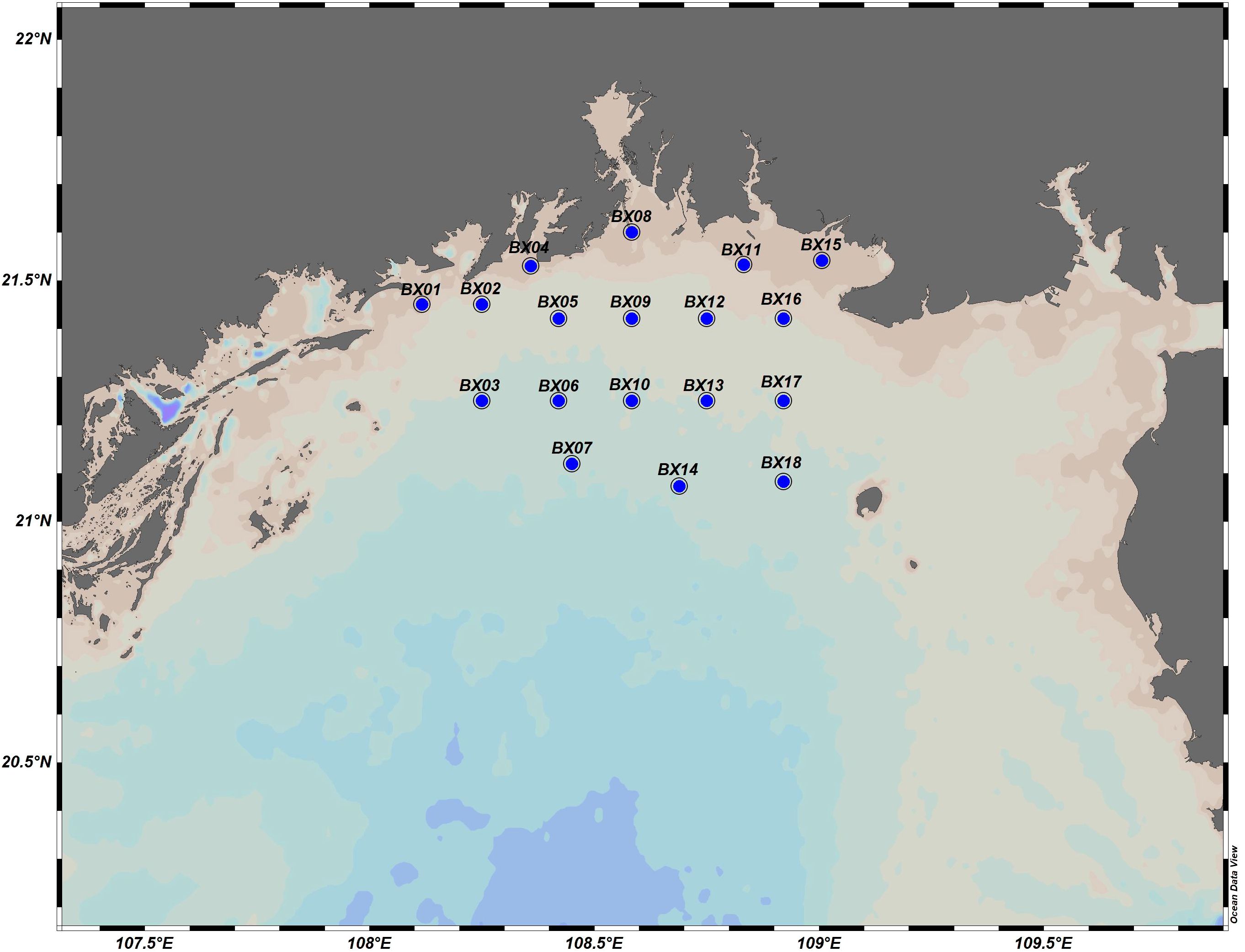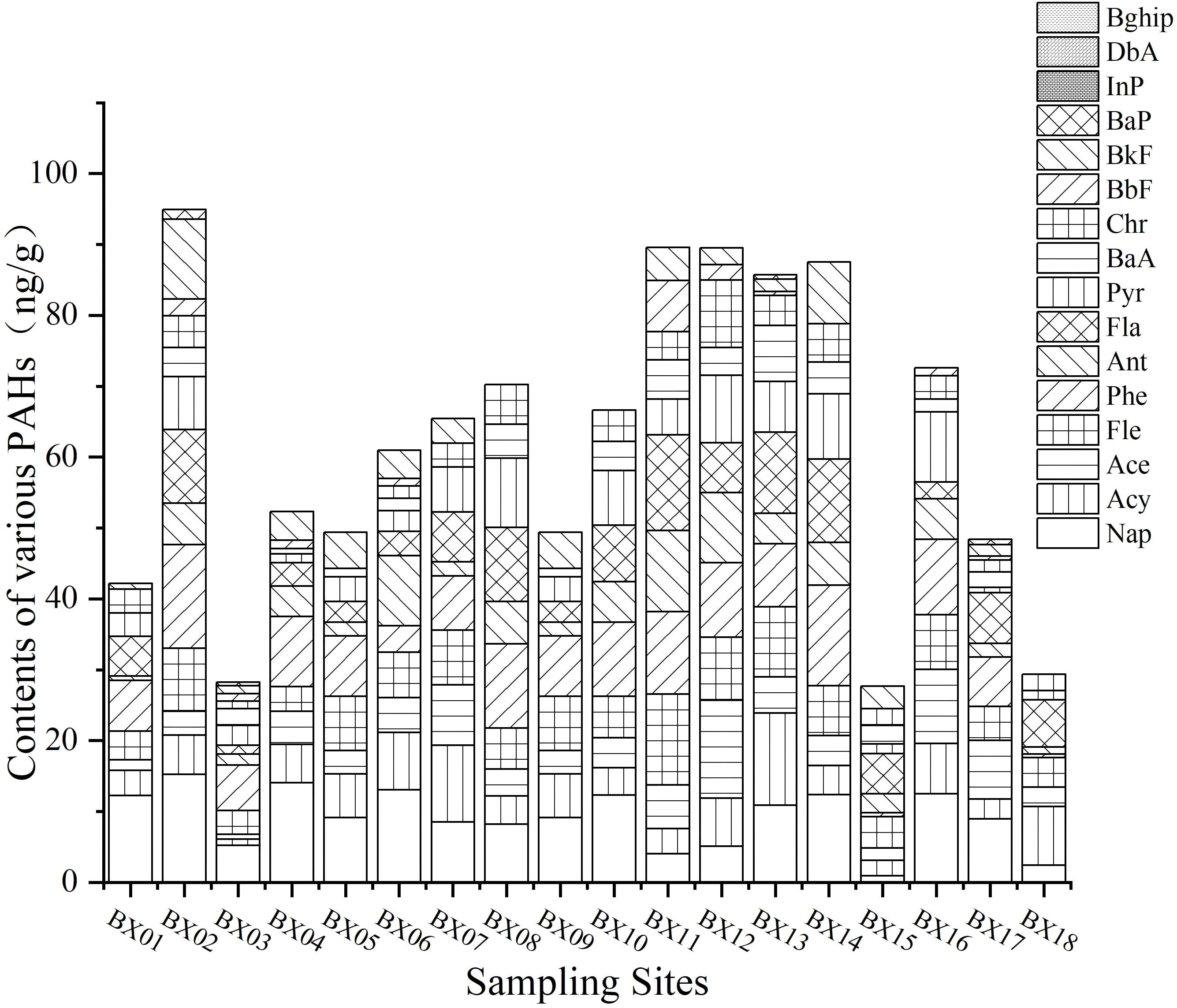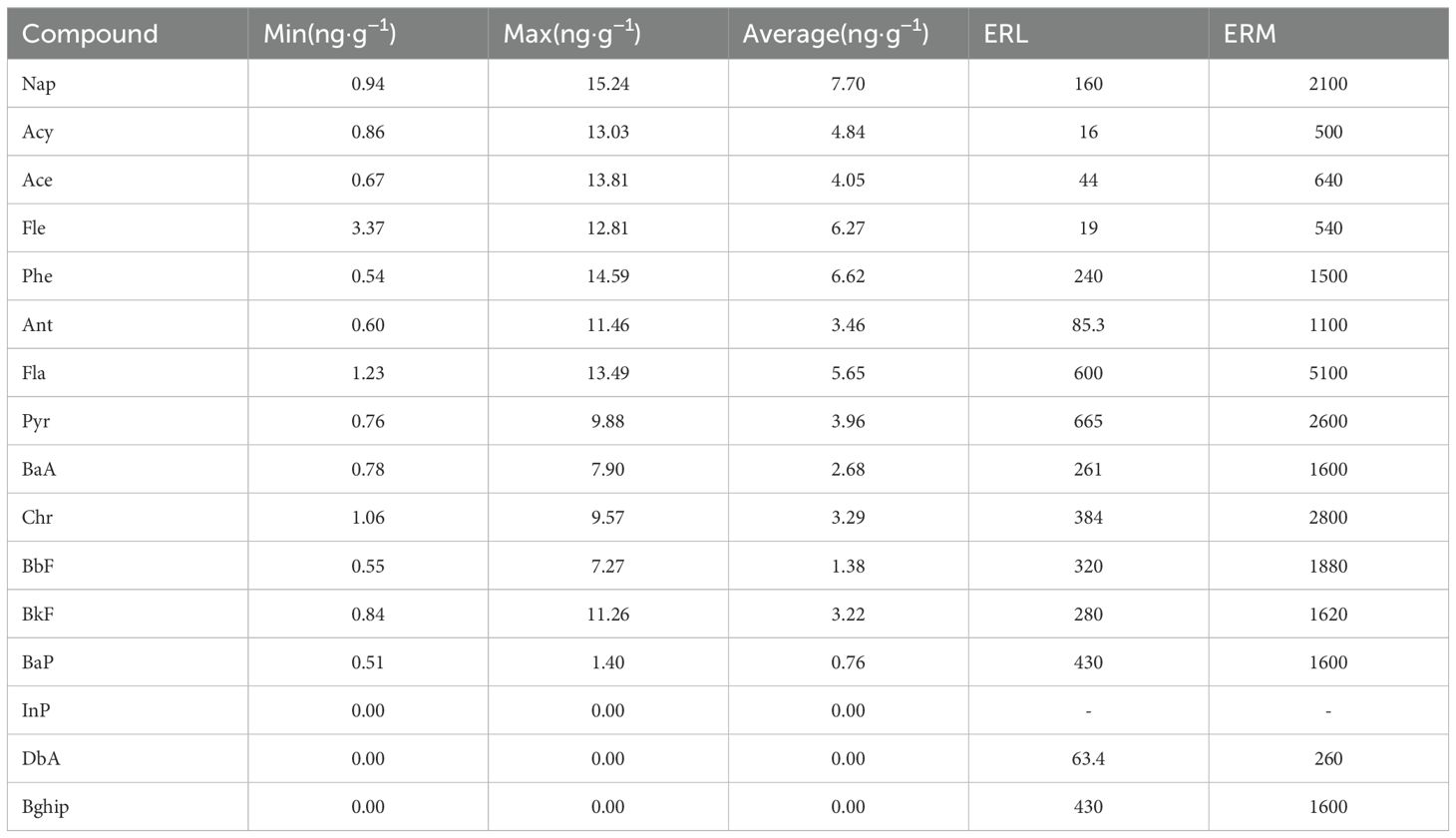- 1Engineering Technology Research Center for Health and Nutritional Baked Foods, Guangzhou College of Technology and Business, Guangzhou, China
- 2Marine Bioresource and Environment Research Center, Key Laboratory of Marine Eco-Environmental Science and Technology, The First Institute of Oceanography, Ministry of Natural Resources, Qingdao, China
- 3Qingdao Innovation and Development Center, Harbin Engineering University, Qingdao, China
Polycyclic aromatic hydrocarbons (PAHs) in marine sediments pose potential ecological risks, and systematic investigations of their distribution, sources, and risks are critical for coastal environmental management.This study systematically investigates the distribution, source apportionment, and ecological risks of 16 polycyclic aromatic hydrocarbons (PAHs) in surface sediments of the western Beibu Gulf, Guangxi. The total PAH concentrations range from 27.65 to 94.96 ng·g⁻¹, with an average of 61.67 ng·g⁻¹, which indicates low-to-moderate pollution. Spatial variations are significant, influenced by riverine inputs and coastal development intensity, with 3-ring (60.35%) and 4-ring (17.84%) compounds dominating. Diagnostic ratio analysis and principal component analysis (PCA) reveal that PAHs primarily originate from coal and biomass combustion, with local petroleum contributions. Risk assessments show that all PAH concentrations are below the Effect Range Low (ERL) of sediment quality guidelines. The toxic equivalent quotient (TEQBaP) averages 0.991 ng·g⁻¹, and RQΣPAHs indicates low ecological risk, though potential accumulation of high-ring PAHs in industrial estuaries requires attention. These findings provide a scientific basis for PAH pollution control and sustainable marine management in the Beibu Gulf.
Highlights
● Western Beibu Gulf sediments show low-to-moderate PAH pollution, dominated by 3/4-ring compounds.
● PAHs mainly from coal/biomass combustion, with local petroleum inputs.
● Low ecological risks overall, but high-ring PAHs in estuaries need attention.
1 Introduction
The western Beibu Gulf of Guangxi, located in the northwestern South China Sea, serves as a key maritime corridor for southwestern China, playing a central role in regional development. Economically, ports like Fangchenggang thrive on this area, handling substantial cargo throughput and functioning as a frontier for foreign trade in southwestern China. This facilitates regional economic integration, and this maritime corridor promotes trade and industrial cooperation between China and ASEAN, drives local economic growth, and optimizes regional resource allocation and technological exchange. Ecologically, this area is an important component of subtropical marine ecosystems, providing habitats for numerous marine organisms, maintaining rich biodiversity, ensuring marine ecosystem stability, and playing an irreplaceable role in global ecological balance, fishery resource conservation, and sustainable utilization of biological resources, which are crucial to the economic livelihood of coastal areas.
Polycyclic aromatic hydrocarbons (PAHs), composed of two or more fused benzene rings, are chemically stable and slow to naturally degrade (Namihira-Santillán et al., 2025; Li et al., 2025). They mainly originate from incomplete combustion of fossil fuels, widely generated in industrial production (e.g., factory boiler combustion, chemical synthesis), transportation (vehicle engine operation, shipping), and daily life (waste incineration, household heating and cooking) (Zhao et al., 2025; Li et al., 2025). PAHs are prone to accumulate in coastal regions. On one hand, estuaries, as transitional zones between land and sea, receive large amounts of terrestrial pollutants, including industrial wastewater, domestic sewage, and PAHs carried by surface runoff. When rivers flow into the sea, the slowing water velocity causes PAH-carrying suspended particles to settle, accumulating in estuarine areas (Tulcan et al., 2024; Zhang et al., 2024). On the other hand, coastal areas near dense human activities, with frequent maritime transportation and oil exploitation, directly input PAHs through ship fuel combustion emissions and oil spills (Olivares-Rubio et al., 2024). Meanwhile, atmospheric deposition is also an important pathway for PAHs to enter coastal waters, as PAHs emitted from industries and cities are transported by the atmosphere and eventually deposited in coastal seas (Fu et al., 2023). These factors collectively make coastal regions the main sinks for PAHs. The coastal regions of the western Beibu Gulf, due to their special geographical location and frequent human activities, may exhibit more prominent PAH accumulation, posing potential threats to the marine ecological environment. Although existing studies on the ecological environment of the western Beibu Gulf have achieved certain results, significant gaps have remained in research on polycyclic aromatic hydrocarbons (PAHs) (Han et al., 2022a; Li et al., 2015). In terms of research scope, the area receives multiple rivers such as the Beilun, Fangcheng, Nanliu, and Qinjiang Rivers, which carry PAHs from terrestrial industrial wastewater, agricultural non-point source pollution, and domestic sewage to enrich in coastal regions. Hydrodynamic, thermohaline conditions, and biological differences in ecological zones at different water depths further influence PAH migration and transformation processes, but related studies are still incomplete. In source apportionment, the area is affected by multiple pollution sources including terrestrial inputs, maritime activities, and atmospheric deposition, with complex interactions among sources and significant seasonal variations in PAH sources (e.g., intensified terrestrial pollution during the rainy season), but it is currently difficult to accurately quantify the contribution rate of each source to PAH pollution in coastal regions. Coastal longwaves further modulate PAH-sediment dynamics: Bragg reflection can trigger harbor oscillations, resuspending PAH-laden sediments (Gao et al., 2024), while periodic seabed topography mitigates resonance, reducing transport (Gao et al., 2023). These processes may affect PAH distribution near Port but were not quantified here.
In risk assessment, existing systems mostly refer to general standards, failing to fully consider the geographical, ecological, and pollution-specific characteristics of the area, especially ignoring PAH pollution features in estuaries and coastal areas, which may lead to deviations in ecological and health risk assessments and inability to provide reliable support for marine environmental protection decisions (Han et al., 2023; Ren et al., 2022).
Given the above status, accurately understanding the distribution, sources, and risk status of PAHs can not only fill the research gap on PAHs in this region and improve the marine pollution research system but also provide strong data support for the formulation and implementation of local marine environmental protection policies. Clarifying pollution sources helps develop targeted prevention and control strategies to reduce PAH emissions and mitigate hazards to marine ecosystems, especially in coastal regions; accurate risk assessment can timely identify potential risks and adopt scientific risk management measures to promote coordinated and sustainable development of regional economy and ecological environment, ensuring marine ecological security and human health.
2 Materials and methods
2.1 Sample collection and treatment
In December 2024, surface sediment samples from 18 stations in the western Beibu Gulf were collected using a grab sampler (Figure 1). Sediments (0–2 cm) were wrapped with tin foil, placed in sealable bags, stored at -20 °C, and transported to the laboratory. Samples were freeze-dried, ground, and passed through a 100-mesh sieve for further use.
2.2 Extraction and analysis
Five grams of freeze-dried sediment samples were loaded into extraction cells and extracted using an accelerated solvent extractor (ASE350, Thermo, USA) with dichloromethane-n-hexane (v/v=1/1) via two extraction cycles. The combined extract was concentrated by nitrogen blowing, purified using an HLB column, and concentrated to 1 mL for instrumental analysis. A gas chromatography-mass spectrometry (GC-MS) system (Agilent 7890A GC/5975C MSD, USA) equipped with an Agilent HP-5MS capillary column (30 m×0.25 mm×0.25 μm) was used. High-purity helium was used as the carrier gas at a flow rate of 1.0 mL/min, with splitless injection (1 μL) at an inlet temperature of 280 °C. The oven temperature program was: starting at 70 °C, increasing to 120 °C at 5 °C/min, then to 300 °C at 10 °C/min, held for 7 min. Mass spectrometry conditions: interface temperature 300 °C, electron impact (EI) ion source, electron energy 70 eV, ion source temperature 230 °C, quadrupole temperature 150 °C. Selected ion monitoring (SIM) mode was adopted (Liu Y et al., 2024; Ye et al., 2024).
This standard reference material is a PAH mixed standard produced by Dikma Technologies, which contains 16 types of PAH compounds. The 16 PAH components included are naphthalene (Nap), acenaphthylene (Acy), acenaphthene (Ace), fluorene (Flu), phenanthrene (Phe), anthracene (Ant), fluoranthene (Fla), pyrene (Pyr), benzo[a]anthracene (BaA), chrysene (Chr), benzo[b]fluoranthene (BbF), benzo[k]fluoranthene (BkF), benzo[a]pyrene (BaP), indeno[1,2,3-cd]pyrene (InP), dibenzo[a,h]anthracene (DahA), and benzo[g,h,i]perylene (BghiP).
To ensure the reliability of analytical data, blank samples, parallel samples, and blank spiking experiments were set up. No PAHs were detected in blank experiments. The relative standard deviations of triplicate samples were 1.39%-3.95%. Recoveries of 16 PAHs ranged from 78.34% to 125.62%, which meets the requirements of EPA Method 8270D (70%–130% for sediment PAH analysis). No PAHs were detected in blank samples, and RSDs of triplicate samples were <4%, indicating no significant contamination during experiments. Thus, no recovery correction was applied to PAH concentrations (Ye et al., 2024). For PAHs with recoveries near the range boundaries (e.g., Nap: 78.34%; BghiP: 125.62%), relative uncertainties were noted in statistical analyses to ensure result reliability. External standard method was used for quantification, with calibration equations of 16 PAHs all having R² > 0.9991 and detection limits ranging from 0.001 to 0.022 ng·g−1, meeting the analytical requirements for PAHs in sediments in this study (Liu X et al., 2024; Ye et al., 2024).
3 Results and discussion
The concentrations and distributions of 16 PAHs in surface sediments from 18 stations in the western Beibu Gulf are shown in Figure 2. It can be seen that the station with the highest total PAHs concentration is BX02, at 94.96 ng·g−1, while the station with the lowest total PAHs concentration is BX15, at 27.65 ng·g−1.The contents of PAHs vary significantly among different stations, possibly related to the inflowing rivers and the degree of coastal development. The average value is 61.67 ng·g−1, which is at a relatively low level. This significant spatial variation correlates closely with pollutant inputs from estuarine rivers and with coastal development intensity, reflecting direct impacts of human activity on contaminant distribution. This study relies on a single sampling campaign conducted in December 2024, which fails to capture seasonal dynamics of PAHs. Previous studies have shown that the western Beibu Gulf experiences significantly increased river discharge during the rainy season (June–August), transporting more terrestrial PAHs into coastal waters. In contrast, the dry season (December–February) is characterized by intensified agricultural straw burning, which may increase the contribution of biomass combustion-derived PAHs. Future research should include multi-season sampling (covering both rainy and dry seasons) combined with hydrodynamic modeling to comprehensively elucidate the spatiotemporal distribution of PAHs in this region.
Compared to adjacent regions, the western Beibu Gulf’s average PAH concentration (61.67 ng·g−1) is lower than that of western Honghai Bay (158.83 ng·g−1, Liu X et al., 2024), Hainan Dongzhai Harbor (244.44 ng·g−1, Zheng et al., 2025), and Shenzhen Dachan Bay (299–2336 ng·g−1, Huang et al., 2023)- this reflects weaker industrial/shipping activity and stronger hydrodynamics [current speed: 0.3 m/s vs. Dachan Bay’s 0.1 m/s, Liu X et al., 2024] that enhance PAH diffusion. It is slightly higher than Leizhou Bay (4.63–28.66 ng·g−1) (a fishery-dominated bay with minimal combustion inputs) and similar to Guangxi mangroves (92.87 ng·g−1, Ye et al., 2024)—the mangrove’s higher concentration stems from higher organic carbon (3.5% vs. 1.2%) enhancing PAH adsorption. Studies indicate that the western Beibu Gulf’s pollution sources are mainly terrestrial inputs and low-intensity human activities, with generally controllable ecological risks, but local pollution aggravation in river estuaries and industrial zones requires attention.
Statistical analysis of PAHs in surface sediments of the western Beibu Gulf by ring structure shows that 3-ring compounds account for the highest proportion (60.35%), followed by 4-ring compounds (17.84%), with 5-ring and 6-ring compounds together accounting for approximately 21.81% (Figures 3, 4). Since PAH toxicity increases with the number of aromatic rings, the dominance of low-ring components indicates relatively low overall toxicity risk in this region. Compared with PAHs in previous studies, those in Guangxi mangrove wetlands predominantly consist of 3-ring and 4-ring compounds (totaling ~70%), similar to the pollution sources identified in this study (terrestrial biomass combustion and light petroleum fraction inputs); western Honghai Bay exhibits 55% 3-ring and 25% 4-ring PAHs, with slightly higher toxicity risks from high-ring PAHs (Liu Y et al., 2024); Hainan Dongzhai Harbor Mangroves contain >50% high-ring PAHs (4-ring and above), with elevated 5-ring PAH concentrations near ports (Zheng et al., 2025). In summary, the PAH toxicity profiles of this study area align with those of relatively clean mangrove wetlands and Leizhou Bay, differing in terms of toxicity from industrially developed bays. Pollution sources are primarily low-toxicity terrestrial inputs, but localized accumulation of high-ring PAHs warrants attention.
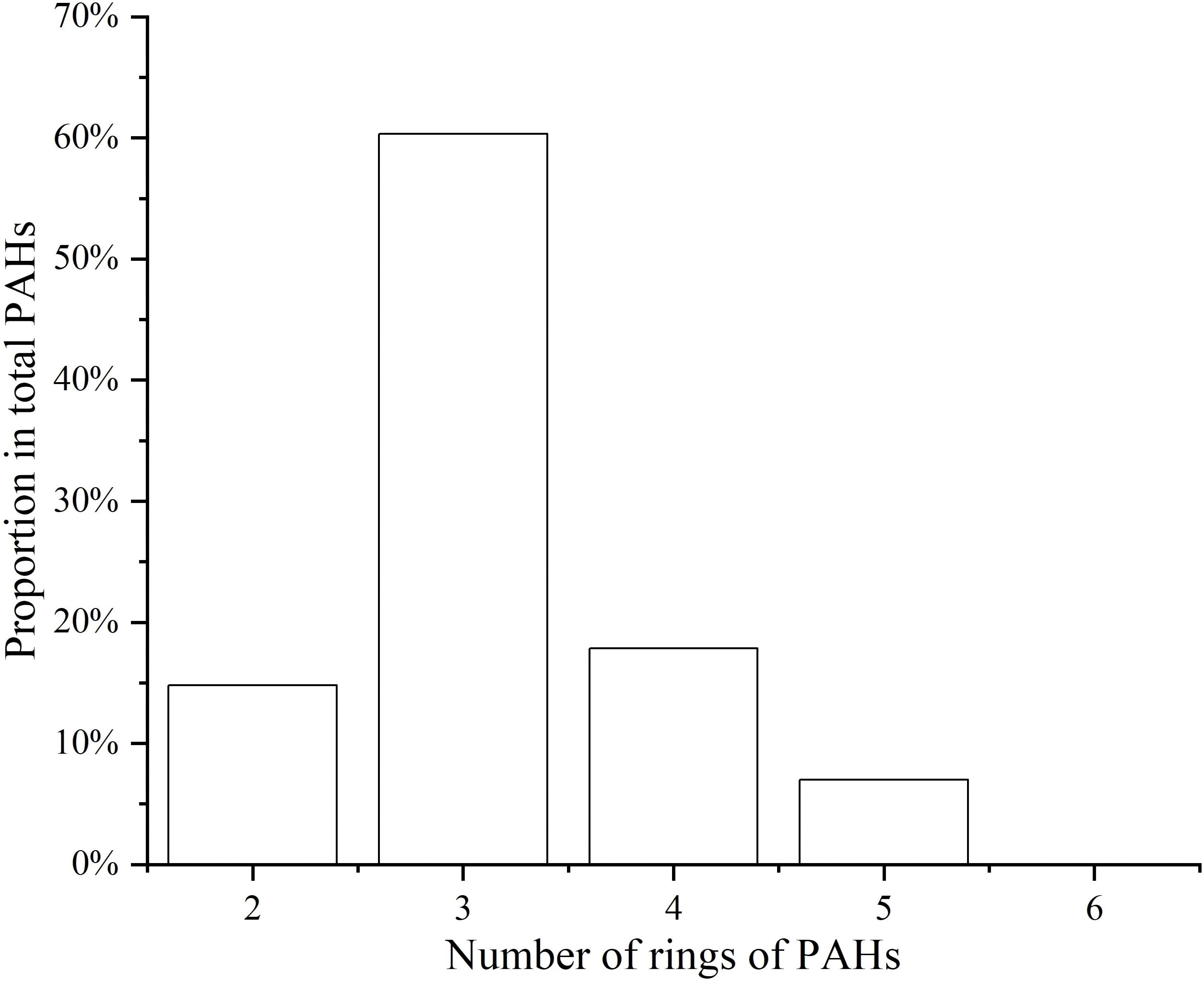
Figure 3. Content proportion of PAHs in surface sediments of the western Beibu Gulf, Guangxi, China.
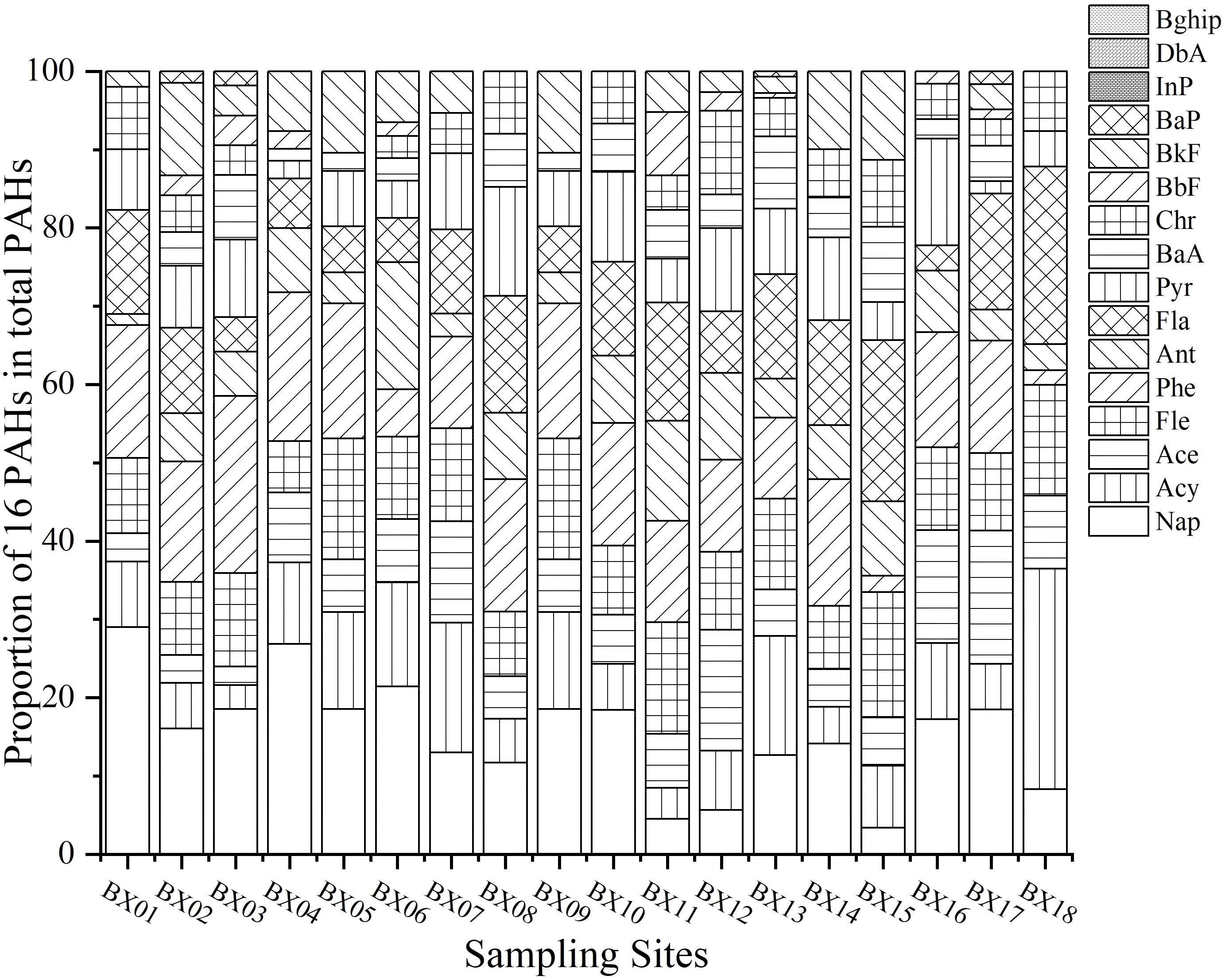
Figure 4. Concentration distribution of 16 PAHs in surface sediments of the western Beibu Gulf, China.
Source apportionment of PAHs was conducted using a combination of the diagnostic ratio method and principal component analysis (PCA) to comprehensively identify the main input pathways of PAHs in surface sediments of the western Beibu Gulf through characteristic compound ratio relationships and multivariate statistical models. The diagnostic ratio method traces pollution sources based on differences in physical and chemical properties of PAH isomers through concentration ratios of characteristic compounds (El-Maradny et al., 2023). In this study, Fla/(Fla+Pyr), Ant/(Ant+Phe), BaA/(BaA+Chr), and InP/(InP+BghiP) were selected as key discriminant indicators (Figure 5). Results show that the Fla/(Fla+Pyr) ratios of most stations in the study area cluster at 0.3–0.5, indicating that PAHs mainly originate from biomass and coal combustion (ratios of 0.4–0.5 typically indicate combustion sources); Ant/(Ant+Phe) ratios are generally lower than 0.1 (<0.1 strongly supports combustion sources), further confirming the dominant role of combustion processes. Additionally, BaA/(BaA+Chr) ratios in a few stations approach 0.3, suggesting possible petroleum pollution (such as ship fuel leakage or industrial petroleum emissions) in local areas. Several sampling sites in Figure 5 fall within ambiguous source zones, likely due to overlapping pollution sources. For example, at BX05, where ship fuel (petroleum source) and coal combustion from coastal factories coexist, the Fla/(Fla+Pyr) ratio falls near the boundary between combustion and petroleum sources. BX08, where mixed inputs from biomass burning (straw) and small-scale petroleum leakage result in a BaA/(BaA+Chr) ratio in the 0.2–0.3 transition zone. To reduce uncertainty, we integrated PCA and PMF results and concluded that combustion sources (coal + biomass) dominate these sites, with petroleum sources as secondary contributors.
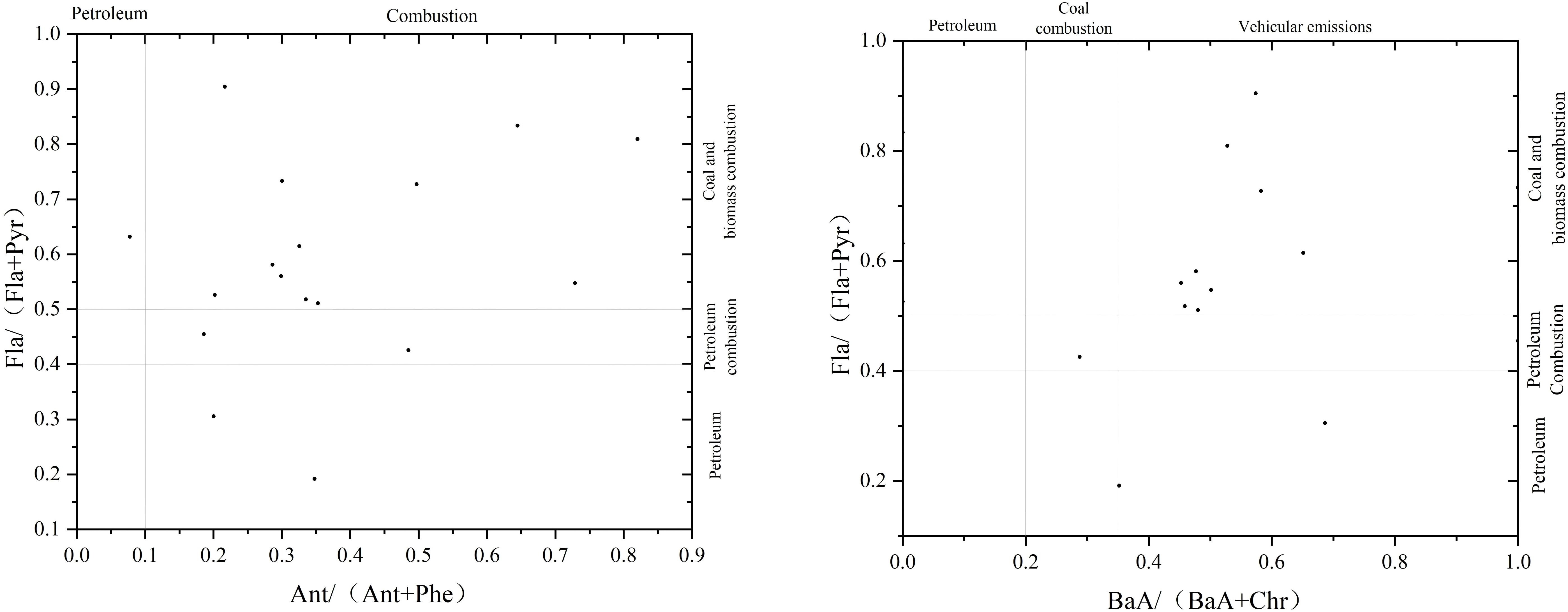
Figure 5. Characteristic ratio diagram of PAHs in surface sediments of the western Beibu Gulf, China.
Principal component analysis simplifies complex data into a few comprehensive variables (principal components) through dimensionality reduction and infers pollution sources based on high-load compounds (Han et al., 2023; Han et al., 2022b). Analysis of 16 PAHs shows that the cumulative variance contribution rate of the first four principal components reaches 78.01%, effectively explaining pollution source characteristics (Table 1): PC1 (variance contribution rate 41.04%), Compounds such as Fle (fluorene), Phe (phenanthrene), Ant (anthracene), Fla (fluoranthene), and Pyr (pyrene) have significant loadings (>0.7). Among them, Fle and Fla are typical markers of coal combustion; Phe and Pyr are related to coal tar processing; and Chr (chrysene) and Ant are often associated with petroleum refining processes (Ye et al., 2024). BbF (benzo[b]fluoranthene), as a product of incomplete mineral fuel combustion, further indicates that PC1 represents a mixed source of coal combustion and petroleum processing. PC2 (variance contribution rate 13.83%): Nap (naphthalene) has the highest loading (0.881), mainly derived from coal combustion and volatile petroleum products, reflecting the influence of coal-based energy use (e.g., industrial coal combustion, heating) in the study area. PC3 (variance contribution rate 13.19%): Acy (acenaphthylene) and Ace (acenaphthene) are the main contributors (loadings > 0.5). Acy is usually associated with oil exploitation and transportation leakage, while Ace is closely related to coke combustion, indicating the superposition of local oil leakage and industrial combustion sources. Combining the results of both methods, PAHs in the western Beibu Gulf mainly originate from coal and biomass combustion, followed by petroleum and its combustion products. Positive Matrix Factorization (PMF) was employed for quantitative source apportionment of PAHs. The input dataset included PAH concentrations from 18 sampling stations. Missing values were replaced with half the method detection limit (MDL), and relative standard deviations (RSDs) were used as uncertainty weights. The optimal number of factors was determined to be 4 through iterative calculations (via minimizing the model’s Q value, which represents the sum of squared residuals between observed and simulated concentrations). The final model’s Q value (actual) was within 10% of the theoretical Q value, indicating good fit.
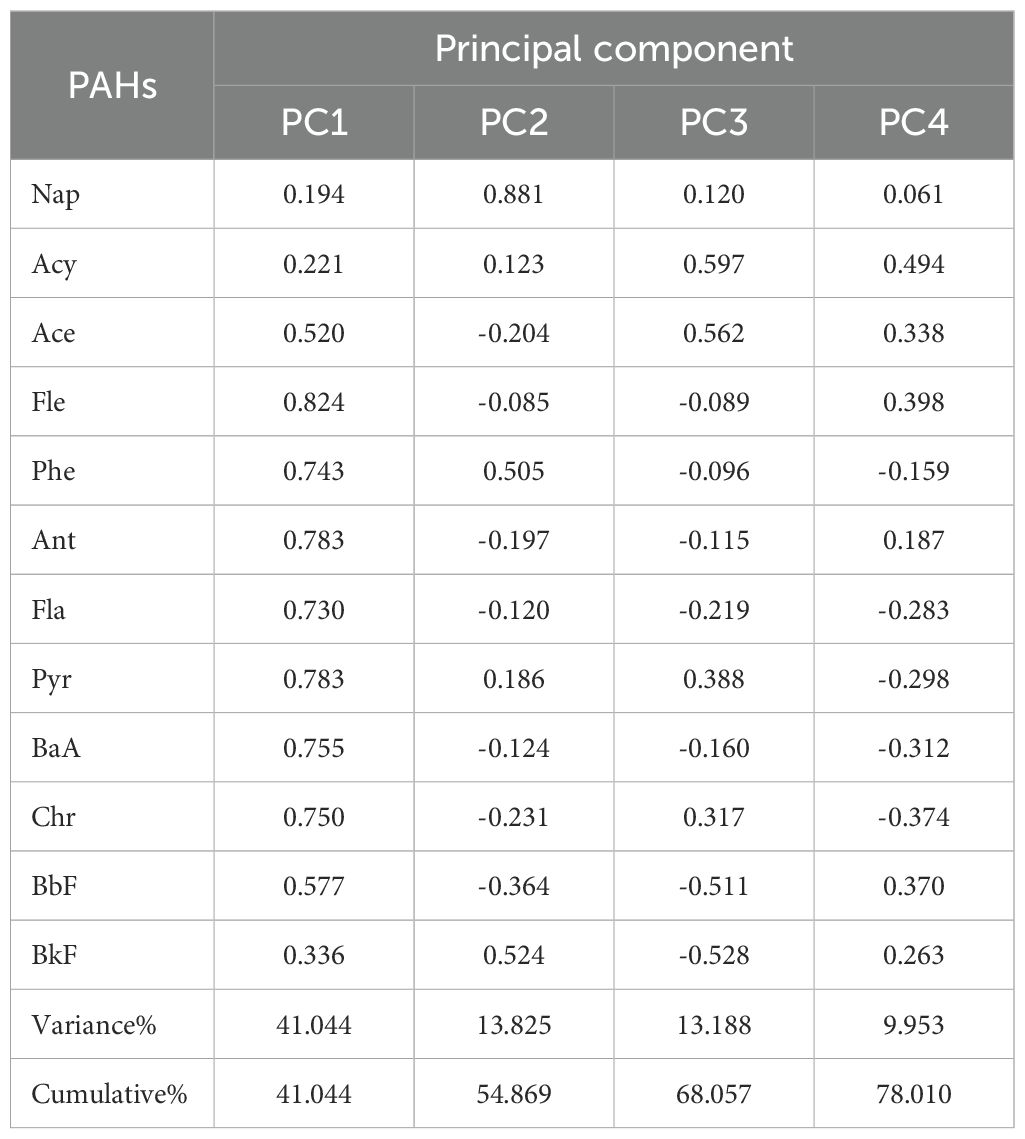
Table 1. Principal component analysis of PAHs in surface sediments of the western Beibu Gulf, China.
This study used the NOAA ERL/ERM guidelines (Calder et al., 1995) for ecological risk assessment, primarily because: (1) it is the most widely used standard for sediment PAH risk assessment globally, facilitating comparisons with domestic and international studies; (2) no unified localized PAH risk thresholds exist for subtropical estuaries in China. However, limitations should be noted: surface sediments in the western Beibu Gulf are dominated by fine-grained silt with an average organic carbon content (1.2%) lower than that of typical North American estuaries (2.5%, Han et al., 2023). Lower organic carbon content may increase the bioavailability of PAHs, meaning ERL/ERM-based assessments may underestimate actual ecological risks. Future studies should combine regional bioassays (e.g., benthic organism exposure tests) to establish localized PAH risk thresholds.
Results show that the highest concentrations of 16 PAHs in all stations of the study area are significantly lower than the ERL, indicating that the minimum risk level potentially harmful to marine organisms has not been reached (Table 2). Taking the strongly carcinogenic BaP (benzo[a]pyrene) as an example, its highest concentration is only 1.40 ng·g−1, only 0.3% of the ERL (430 ng·g−1); the highest concentrations of the 4-ring compounds Fla (fluoranthene) and Pyr (pyrene) are 13.49 ng·g−1 and 9.88 ng·g−1, respectively, only 2.25% and 1.48% of the corresponding ERL thresholds. This result indicates that PAH pollution in the western Beibu Gulf has not posed significant threats to benthic organisms, fish, and other marine organisms, remaining at a low ecological risk baseline level.
TEQBaP (Benzo[a]pyrene Toxic Equivalent) is a common method for evaluating the comprehensive toxicity of pollutants with similar toxic mechanisms such as polycyclic aromatic hydrocarbons (PAHs). It quantifies the overall hazard of mixed pollutants by converting the toxicity of different PAHs into the equivalent toxicity of the strong carcinogen BaP through Toxic Equivalent Factors (TEFs) (Zafeiraki et al., 2023). The TEQBaP in the study area ranges from 0.058 to 3.338 ng·g−1, with an average of 0.991 ng·g−1 (Figure 6), significantly lower than that in Hainan Dongzhai Harbor Mangrove Wetlands (average 12.08 ng·g−1) (Zheng et al., 2025). Among them, Station BX02 has the highest TEQBaP due to its proximity to industrial docks and river estuaries, mainly contributed by 4-ring and 5-ring PAHs such as Fla (fluoranthene, TEF = 0.001) and BaA (benzo[a]anthracene, TEF = 0.1); while Station BX15 (TEQBaP=0.058 ng·g−1), far from human activities, has a toxicity equivalent approaching background levels. It is noteworthy that although the overall toxicity risk is low, the potential bioaccumulation of 4-ring and higher PAHs still requires attention, as they can exert chronic toxicity on higher organisms through food chain transfer (Liao et al., 2019).
The Risk Quotient (RQ) method, a common approach for assessing ecological risks of polycyclic aromatic hydrocarbons (PAHs), quantifies the ratio of pollutant concentrations to toxicity thresholds to achieve joint risk classification for single or multi-component PAHs (Shi et al., 2024). Risk Quotient (RQ) is an indicator used to assess the risk level of pollutants by comparing the measured concentration of a pollutant with its Predicted No-Effect Concentration (PNEC). The commonly applied classification criteria are as follows: an RQ value ≥ 1 indicates a high risk; an RQ value between 0.1 (inclusive) and 1 (exclusive) indicates a medium risk; and an RQ value < 0.1 indicates a low risk. For individual PAHs, RQ < 1 = low risk, 1 ≤ RQ < 10 = moderate risk, RQ ≥ 10 = high risk; for total PAHs (RQΣPAHs), < 10 = low risk, 10 ≤ RQΣPAHs < 100 = moderate risk, ≥ 100 = high risk. This standard is based on PAH risk assessment studies in Chinese coastal sediments and has been validated in regions such as Laizhou Bay and the Red Sea (Shi et al., 2024; El-Maradny et al., 2023), making it well-suited for subtropical estuaries like the study area. RQ calculations show that all PAHs have RQ values < 1, with Nap (naphthalene) and Fle (fluorene) having relatively high average RQs of 6.519 and 5.585, respectively, but still below the low-risk threshold of NCs (RQNCs < 10) (Table 3). The comprehensive risk quotient RQΣPAHs indicates that risk values across all stations range from 1 to 100, belonging to the low ecological risk grade, suggesting limited potential harm of PAHs to the sediment-water interface ecosystem (Figure 7). Compared with highly urbanized bays like Shenzhen Dachan Bay (RQΣPAHs often exceeding 500) (Huang et al., 2023), the study area experiences significantly lower human activity interference.
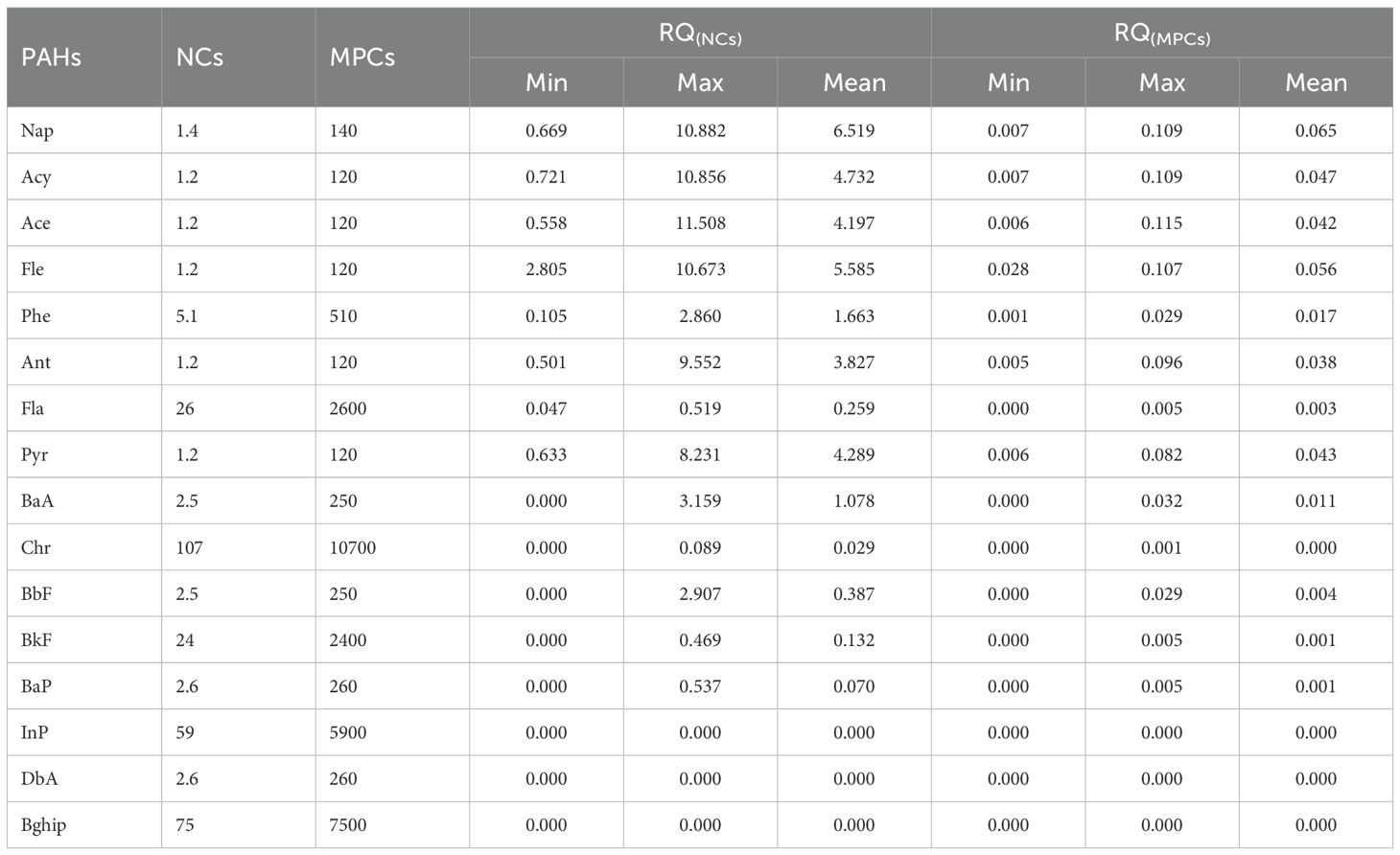
Table 3. Analysis of RQ (NCs) and RQ (MPCs) of PAHs in surface sediments of the western Beibu Gulf, China.
Spatial variations in PAH risks are closely related to pollution source distributions. High-risk stations (e.g., BX02) located near ship anchorages have PAH concentrations 40% higher than the average, with high-ring components (4-ring and above) accounting for 35%, reflecting the superposition of industrial coal combustion and ship fuel emissions. In contrast, low-risk stations (e.g., BX15, BX18) are mostly distributed in offshore areas, dominated by 3-ring compounds (e.g., Phe, Ant) accounting for >65%, with pollution sources mainly from biomass inputs such as agricultural straw combustion, featuring low toxicity intensity. This feature is fully consistent with the source apportionment results from diagnostic ratio methods and PCA. In domestic mangrove wetlands: Guangxi mangrove wetlands have an average PAH concentration of 92.87 ng·g−1 and average TEQBaP of 12.08 ng·g−1 (Ye et al., 2024); Hainan Dongzhai Harbor Mangroves have an average PAH concentration of 244.44 ng·g−1 (Zheng et al., 2025). Both the total amount and toxicity of PAHs in the western Beibu Gulf are lower than the above regions, possibly due to the higher organic carbon content in mangrove sediments (with stronger adsorption capacity) and the lower intensity of industrial activities in this region.
4 Conclusions
This study revealed the environmental behavior and ecological effects of polycyclic aromatic hydrocarbons (PAHs) in surface sediments of the western Beibu Gulf, Guangxi. The results show that PAH pollution in this area exhibits significant spatial differentiation, with total concentrations at low-to-moderate levels and dominated by low-ring (3-ring, 4-ring) components, reflecting the combined influence of terrestrial combustion sources and mild human activities. Source apportionment confirms that coal and biomass combustion are the main contributors, with local disturbances from petroleum-derived pollution, which is highly consistent with the regional energy structure and coastal activity characteristics. PMF analysis further quantified the contributions of PAH sources in the western Beibu Gulf sediments: coal combustion (38.2%), biomass combustion (29.5%), petroleum sources (22.3%), and mixed sources (10.0%, coal combustion + petroleum processing). Coal combustion sources were found to be related to coastal industrial boilers and residential heating. In contrast, biomass combustion was linked to the burning of agricultural straw in the upstream areas of the watershed. Petroleum-related sources, on the other hand, were associated with ship fuel leakage—specifically from Fangcheng Port—and small-scale nearshore oil exploitation activities. This quantitative result aligns with diagnostic ratio and PCA findings, confirming the dominance of combustion sources. Risk assessment frameworks (ERL/ERM, TEQBaP, RQ methodology) consistently show that the overall ecological risk remains within acceptable limits, though potential bioaccumulation of high-ring PAHs in industrial estuaries warrants continued vigilance. Compared with surrounding typical regions, the PAH pollution intensity in the study area is lower than that in industrial bays and similar to mangrove wetlands, highlighting the buffering effect of subtropical estuarine-coastal ecosystems on terrestrial pollution. This study not only addresses the data gap regarding polycyclic aromatic hydrocarbons (PAHs) in this region but also, from the perspective of regional ecological security, proposes the construction of an integrated protection system encompassing “pollution source control, sensitive area monitoring, and ecological function enhancement.” The system should prioritize strengthening pollution source tracing and management in industrial estuaries and shipping channels, while leveraging the carbon sequestration and pollutant interception capabilities of mangrove wetlands to advance the sustainable management of the marine ecological environment. Subsequent studies should establish a long-term, multi-seasonal monitoring framework for PAHs to fill gaps in temporal dynamics, providing more precise data support for pollution control strategies.
Data availability statement
The original contributions presented in the study are included in the article/supplementary material. Further inquiries can be directed to the corresponding authors.
Author contributions
DC: Data curation, Investigation, Writing – original draft. YX: Data curation, Writing – review & editing. ZH: Methodology, Writing – review & editing. HX: Conceptualization, Investigation, Writing – review & editing.
Funding
The author(s) declare financial support was received for the research and/or publication of this article. We gratefully acknowledge the financial support from the National Key Research and Development Program of China (Grant No. 2024YFC2813604).
Conflict of interest
The authors declare that the research was conducted in the absence of any commercial or financial relationships that could be construed as a potential conflict of interest.
Generative AI statement
The author(s) declare that no Generative AI was used in the creation of this manuscript.
Any alternative text (alt text) provided alongside figures in this article has been generated by Frontiers with the support of artificial intelligence and reasonable efforts have been made to ensure accuracy, including review by the authors wherever possible. If you identify any issues, please contact us.
Publisher’s note
All claims expressed in this article are solely those of the authors and do not necessarily represent those of their affiliated organizations, or those of the publisher, the editors and the reviewers. Any product that may be evaluated in this article, or claim that may be made by its manufacturer, is not guaranteed or endorsed by the publisher.
References
Calder F. D., MacDonald D. D., Long E. R., and Smith S. L. (1995). Incidence of adverse biological effects within ranges of chemical concentrations in marine and estuarine sediments. Environ. Manage. 19, 81–97. doi: 10.1007/BF02472006
El-Maradny A., Orif M., AlKobati A., Ghandourah M., and Al-Farawati R. (2023). Polycyclic aromatic hydrocarbons in the sediments of highly polluted coastal area in the Red Sea: levels, spatial distribution, and risk assessment. Environ. Monit. Assess. 195, 1547. doi: 10.1007/s10661-023-12157-x
Fu J., Zhang H., Li R., Shi T., Gao H., Jin S., et al. (2023). Occurrence, spatial patterns, air - seawater exchange, and atmospheric deposition of polycyclic aromatic hydrocarbons (PAHs) from the Northwest Pacific to Arctic Ocean. Mar. Environ. Res. 183, 105793. doi: 10.1016/j.marenvres.2022.105793
Gao J. L., Hou L. H., Liu Y. Y., and Shi H. B. (2024). Influences of bragg reflection on harbor resonance triggered by irregular wave groups. Ocean Eng. 305, 117941. doi: 10.1016/j.oceaneng.2024.117941
Gao J. L., Shi H. B., Zang J., and Liu Y. Y. (2023). Mechanism analysis on the mitigation of harbor resonance by periodic undulating topography. Ocean Eng. 281, 114923. doi: 10.1016/j.oceaneng.2023.114923
Han M., Liu F., Kang Y., Zhang R., Yu K., Wang Y., et al. (2022a). Occurrence, distribution, sources, and bioaccumulation of polycyclic aromatic hydrocarbons (PAHs) in multi environmental media in estuaries and the coast of the Beibu Gulf, China: a health risk assessment through seafood consumption. Environ. Sci. pollut. Res. Int. 29, 52493–52506. doi: 10.1007/s11356-022-19542-y
Han M., Yu K., Zhang R., Chen B., Li H., Zhang Z.-E., et al. (2023). Sources of the elevating polycyclic aromatic hydrocarbon pollution in the western South China Sea and its environmental implications. Environ. Sci. Technol. 57, 20750–20760. doi: 10.1021/acs.est.3c03452
Han M., Zhang R., Yu K., Yan A., Li H., Zhang R., et al. (2022b). Environmental fate and effects of PAHs in tropical mariculture ponds near the northern South China Sea: Rainfall plays a key role. Sci. Total Environ. 847, 157442. doi: 10.1016/j.scitotenv.2022.157442
Huang W., Liu B., Zhao H., Zhao L., and Zhang J. (2023). Spatial distribution and sources of polycyclic aromatic hydrocarbons in sediments from dachan bay, shenzhen city. Water 15, 1848. doi: 10.3390/w15101848
Li J., Tong Y., Gong Q., Tian Y., Yang Y., Wen L., et al. (2025). Cultured shrimp Penaeus vanmamei from eastern China accumulates PAHs and PYRs through different pathways: Water and food sources matter. Aquaculture 598, 742060. doi: 10.1016/j.aquaculture.2024.742060
Li P. Y., Xue R., Wang Y. H., Zhang R. J., and Zhang G. (2015). Influence of anthropogenic activities on PAHs in sediments in a significant gulf of low-latitude developing regions, the Beibu Gulf, South China Sea: Distribution, sources, inventory and probability risk. Mar. pollut. Bull. 90, 218–226. doi: 10.1016/j.marpolbul.2014.10.048
Liao X., Wu Z., Li Y., Cao H., and Su C. (2019). Effect of various chemical oxidation reagents on soil indigenous microbial diversity in remediation of soil contaminated by PAHs. Chemosphere 226, 483–491. doi: 10.1016/j.chemosphere.2019.03.126
Liu Y., Han B., Wang G., Zheng L., and Lu Z. (2024). Distribution characteristics, source analysis and ecological risk assessment of polycyclic aromatic hydrocarbons in surface sediments from the western Honghai Bay of China. Mar. pollut. Bull. 208, 117001. doi: 10.1016/j.marpolbul.2024.117001
Liu X., Hong X., Song H., Zhang T., Chen K., and Chu J. (2024). Exploring source-specific ecological risks of PAHs near oil platforms in the Yellow River Estuary, Bohai Sea. Mar. pollut. Bull. 207, 116870. doi: 10.1016/j.marpolbul.2024.116870
Namihira-Santillán P. E., Olivares-Rubio H. F., Velandia-Aquino L. B., and Ponce-Vélez G. (2025). PAHs in sediments and shrimps: Levels, sources, and risk estimation in a tropical coastal lagoon system near oil industry. Mar. pollut. Bull. 214, 117812. doi: 10.1016/j.marpolbul.2025.117812
Olivares-Rubio H. F., Ontiveros-Cuadras J. F., Celis-Hernández O., Salazar-Remigio L., Santiago-Pérez S., Girón-García M. P., et al. (2024). Spatial distribution of PAHs, nickel, and vanadium in sediments from a large coastal lagoon near a petroleum extraction area in the southern Gulf of Mexico. Mar. pollut. Bull. 207, 116901. doi: 10.1016/j.marpolbul.2024.116901
Ren C., Tan X., Huang C., Zhao H., and Lan W. (2022). Sources, pollution characteristics, and ecological risk assessment of steroids in beihai bay, guangxi. Water 14, 1399. doi: 10.3390/w14091399
Shi D., Wu F., He J., Sun Y., Qin N., Sun F., et al. (2024). Spatiotemporal distributions and ecological risk of polycyclic aromatic hydrocarbons in the surface seawater of Laizhou Bay, China. Environ. Sci. pollut. Res. Int. 31, 12131–12143. doi: 10.1007/s11356-023-31253-6
Tulcan R. X. S., Liu L., Lu X., Ge Z., Fernández Rojas D. Y., and Mora Silva D. (2024). PAHs contamination in ports: Status, sources and risks. J. Hazardous Materials 475, 134937. doi: 10.1016/j.jhazmat.2024.134937
Ye Z., Han B., Wang G., Lei X., Qing S., Su Q., et al. (2024). Occurrence status, source analysis and risk assessment of polycyclic aromatic hydrocarbons in intertidal surface sediments of typical mangrove wetlands in Guangxi Province, China. Mar. pollut. Bull. 209, 117170. doi: 10.1016/j.marpolbul.2024.117170
Zafeiraki E., Moulas E., Kasiotis K. M., Bakeas E., and Dassenakis E. (2023). Polycyclic aromatic hydrocarbons (PAHs) in surface sediments from Greece: Occurrence, sources and risk assessment. Mar. pollut. Bull. 197, 115715. doi: 10.1016/j.marpolbul.2023.115715
Zhang F., Zhang D., Lou H., Li X., Fu H., Sun X., et al. (2024). Distribution, sources and ecological risks of PAHs and n - alkanes in water and sediments of typically polluted estuaries: Insights from the Xiaoqing River. J. Environ. Manage. 364, 121471. doi: 10.1016/j.jenvman.2024.121471
Zhao X. Y., Ji Y. Q., Bai W. Y., Guo L. Y., Gu C., Liang H. D., et al. (2025). Spatial variations of PM2.5 - bound parent, nitrated and oxygenated PAHs at urban and suburban sites in the Ili River Valley: Characteristics, sources and health risks. J. Environ. Sci. 154, 1–14. doi: 10.1016/j.jes.2024.06.031
Zheng L., Han B., Wang G., Yin X., Sun Y., and Yan W. (2025). Polycyclic aromatic hydrocarbons in intertidal surface sediments of mangrove wetlands in Dongzhai Harbor, Haikou, China: Understanding sources, distribution, and ecological risk. Mar. pollut. Bull. 216, 117950. doi: 10.1016/j.marpolbul.2025.117950
Keywords: western Beibu Gulf, surface sediments, polycyclic aromatic hydrocarbons (PAHs), source apportionment, ecological risk assessment
Citation: Cui D, Xu Y, Hou Z and Xu H (2025) PAHs in subtropical estuarine sediments of western Beibu Gulf, China: distribution, source apportionment, and ecological risk assessment. Front. Mar. Sci. 12:1700618. doi: 10.3389/fmars.2025.1700618
Received: 07 September 2025; Accepted: 03 November 2025;
Published: 28 November 2025.
Edited by:
Yifei Zhao, Nanjing Normal University, ChinaReviewed by:
Junliang Gao, Jiangsu University of Science and Technology, ChinaDong Li, Ministry of Natural Resources, China
Copyright © 2025 Cui, Xu, Hou and Xu. This is an open-access article distributed under the terms of the Creative Commons Attribution License (CC BY). The use, distribution or reproduction in other forums is permitted, provided the original author(s) and the copyright owner(s) are credited and that the original publication in this journal is cited, in accordance with accepted academic practice. No use, distribution or reproduction is permitted which does not comply with these terms.
*Correspondence: Zhenzhen Hou, aG91emhlbnpoZW5AZ3pncy5lZHUuY24=; Haiping Xu, eHVoYWlwaW5nQGd6Z3MuZWR1LmNu
 Dongyang Cui1
Dongyang Cui1 Haiping Xu
Haiping Xu